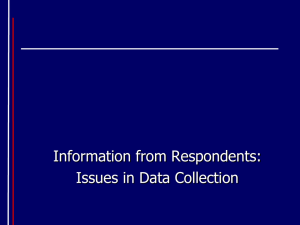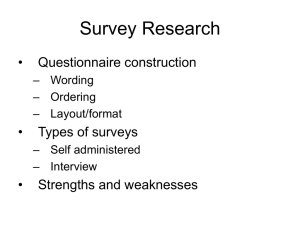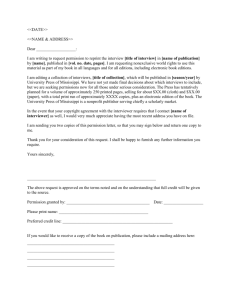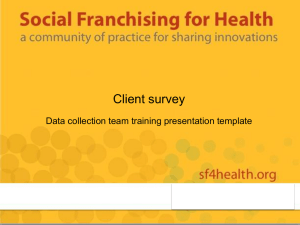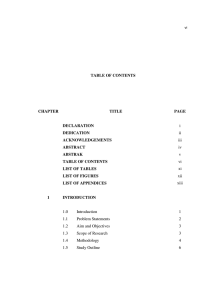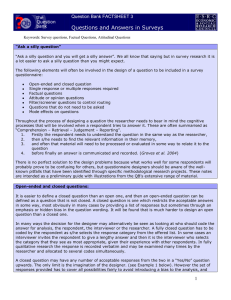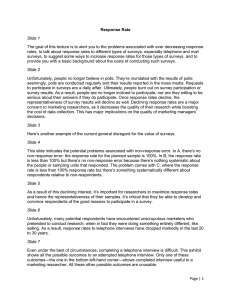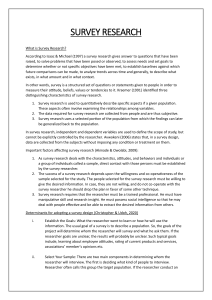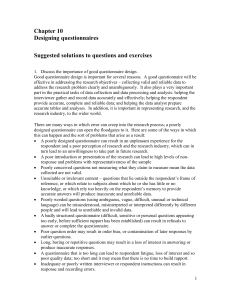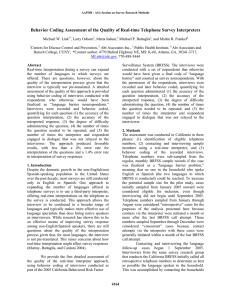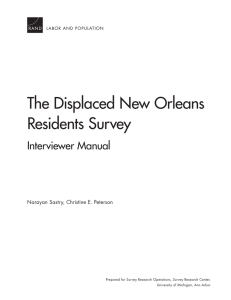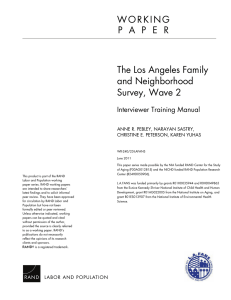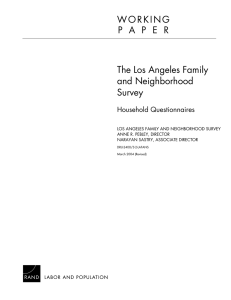Marketing Research - People Search Directory
advertisement
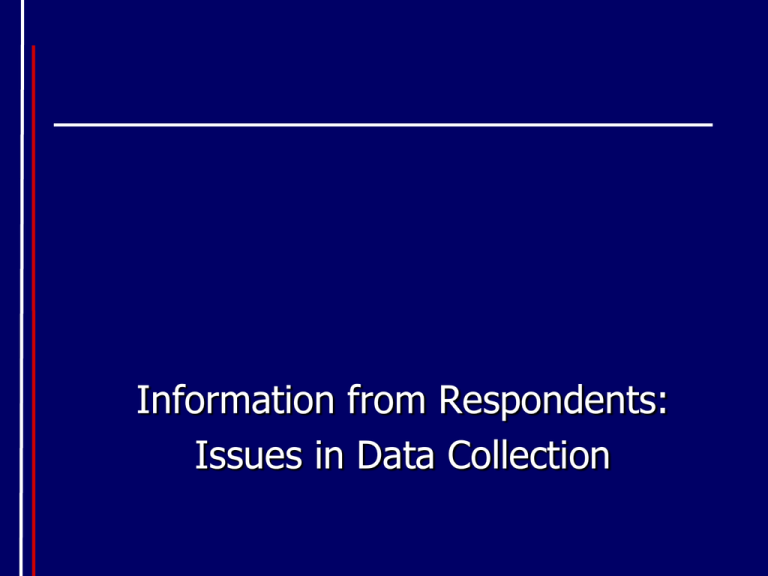
Information from Respondents: Issues in Data Collection Widely used media for collecting primary data • Questionnaires • Observation • Combining methods in data collection – E.g. Brand preferences influenced by advertising. How will you combine an experiment with an observation? – Gerald Gorn’s experiment Interviewee Issues: Non-response • Refusals – – – – Due to ambiguous, hard-to-understand questionnaires Due to respondent characteristics Invasion of privacy Time pressure and fatigue • Inability to respond – Genuine forgetting – Ignorance • How will you minimize non-response issues? Interviewee Issues: Inaccurate Response • Concern about invasion of privacy • Time pressure and fatigue • Prestige seeking and social desirability bias • Courtesy bias • Telescoping • Averaging Interviewer Issues • Fraud and deceit – Submitting fabricated responses • Probing questions – Steer responses to acceptable one • Interviewer attitudes and interest – Do you appear disinterested in the survey or have a bad attitude about it? • How will you minimize interviewer issues? Widely used methods of Data Collection • Personal Interview • Telephone Interview • Mail Survey • Web-based Survey Personal Interviews Four Entities Involved • Researcher–Questionnaire design and procedure • Interviewer-attitudes & procedure • Interviewee-respondent characteristics • The Interview Environment-where? How much time? Home? Office? Etc. • Interaction between any or all of these entities influences responses Personal Interviews Methods • Door to Door Interviewing – Costliest, influenced by environment, ability to explain complicated procedures and show & demonstrate product • Executive Interviewing – Similar to door-to-door but in the industrial context • Mall Intercept Surveys – Cheaper, requires mall management cooperation Personal Interviews • Purchase Intercept Technique (PIT) – Observation + interview in store – E.g. to understand the amount of information search conducted by the shopper just prior to choosing the product in store. • Self-administered questionnaire – Respondent may misunderstand questions, no interviewer bias Telephone Interviewing - issues • Selecting telephone numbers – Pre specified list (membership rosters, customer lists, etc.) – A directory (telephone, etc. problem – unlisted numbers) – Random dialing procedure • Random digit dialing – out of service numbers, no geographical focus possible • Systematic random digit dialing (SRDD) – geographical focus possible • Cost – cheaper and faster than personal interviews Telephone interviews - issues • The introduction – Establish rapport immediately – Short, succint but brief introduction • When to call – – – – Varies according to the respondent Housewives: between 9 am and 4.30 pm Generally a good time is 6.30 pm to 9 pm Weekends: 10 am to 8 pm • Call reports – Records the date, time and outcomes of the call Mail Surveys Decisions to Be Made • Postage pre-paid return envelope • Method of Addressing (first name/last name/Sir, etc.) • Cover Letter • The Questionnaire Length, Layout, Color, Format, Etc • Method of Notification (pre-recruitment) • Reminders • Incentive to Be Given Mail surveys – possible problems • • • • • • • • Who answers – respondent or somebody else Did the respondent get help in answering? Speed of response (time lag delays the study) Order of questions is compromised (no funnel effect) Not understanding the questions Opportunity to probe for more information not present Obsolete, inaccurate mailing list Low response rates Factors Affecting Response Rates • Perceived amount of work required, and the length of the questionnaire • Intrinsic interest in the topic • Characteristics of the sample • Credibility of the sponsoring organization • Level of induced motivation How to reduce non-response possibilities • Anonymity, confidentiality • Appeals (e.g. students doing survey to get grades) • Obtain permission to do survey • Follow ups • Incentives • Personalize • Questionnaire length and design • Reply-paid enclosed envelope Factors Affecting the Choice of a Survey Method • Sampling (local, regional, national, etc.) • Type of Population (e.g. illiterate, challenged) • Question Form – close-ended questions • Question Content – sensitive issues • Response Rate required • Costs • Available Facilities • Length of Data Collection period Ethical Issues in Data Collection Rights of the Respondents Violated if: • Purpose of a particular measurement disguised • True duration of the interview not revealed • Compensation is misrepresented • Intended follow-up interview not mentioned • Hidden tape recorders used • Respondents not briefed • Interview is guise for selling or fund raising Cover Letter • Purpose of the questionnaire should be stated • Researcher’s contact information • “Response is voluntary” & “you are free to pull out at any time” – “your filling up and sending the survey is indicative of your voluntary participation in the study” • Responses will be kept confidential / anonymous (you should know how) Cover letter (continued) • Sponsoring organization name • Reviewed by Human Subjects Committee • “Take all reasonable steps to protect your identity” • How long will the participation last
